| |
| |
It was 1874 when Elijah Davidson followed his howling bear-chasing dog into a dark abyss now known as Oregon Caves. This day I was part of a group descending into areas of the cave never explored by Davidson and rarely seen by most visitors to the place known for the past century-plus as Oregon Caves National Monument. |
|
| |
|
|
| |
 |
|
| |
Crawling through a narrow cave slot |
|
| |
|
|
| |
For nearly four hours we wriggled like slithering snakes through squeeze holes not much larger than toilet bowls, slipped through mucky passages and belly-slid into a curiouser and curiouser fantasy world.
Most Oregon Caves’ visitors take the conventional cave tour, a moderately strenuous 90-minute guided walk that takes advantage of the cave’s trails and interior lighting system. It’s a fantastic, don’t-miss introduction to the subterranean world of Oregon Caves, which is actually a single cave with a network of side passages. Fewer take ranger-guided candlelight tours, where illumination is provided from a lighted candle in a wooden candle lantern. |
|
| |
|
|
|
|
|
|
| |
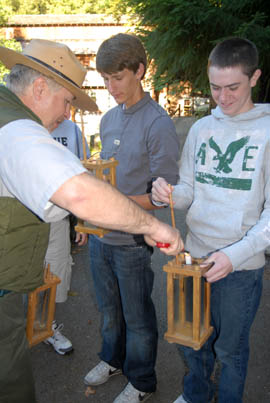 |
|
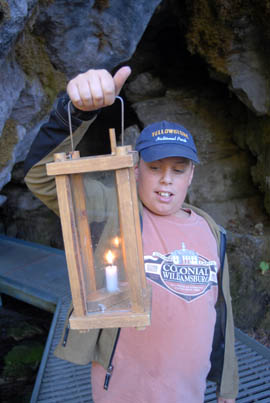 |
|
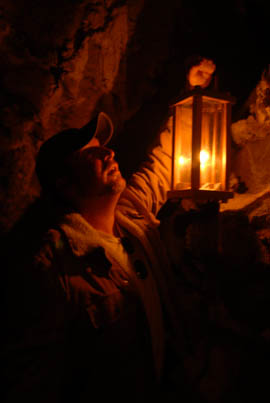 |
|
| |
Lighting up |
|
Ready to go |
|
Exploring by candlelight |
|
| |
|
|
| |
But even fewer - six people on Sunday afternoons from late June through early September - take the wondrously adventurous off-trail tours. The park provides headlamps, hard hats, kneepads - and the opportunity to gain worm-like perspectives of the cave’s interior. It’s definitely not for the claustrophobic. |
|
| |
|
|
| |
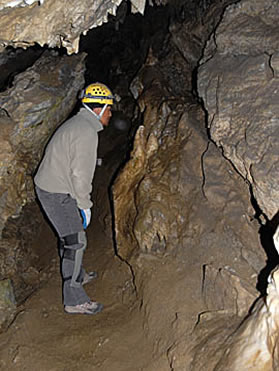 |
|
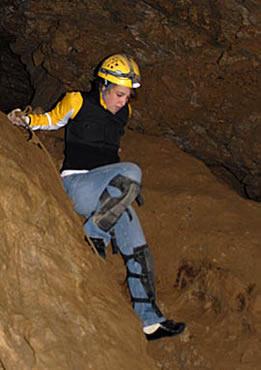 |
|
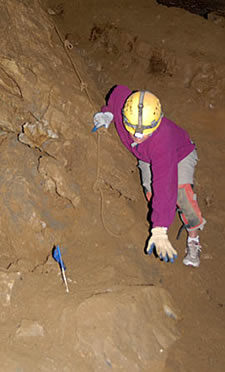 |
|
| |
Checking the formations |
|
Traveling off-trail |
|
Cave climbing |
|
| |
|
|
|
|
|
|
| |
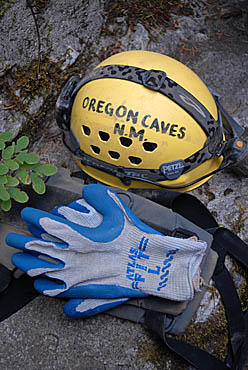 |
|
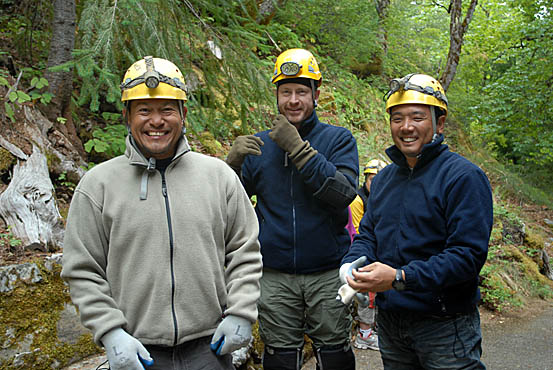 |
|
| |
Off-trail gear |
|
Ready to go |
|
| |
However it’s visited, Oregon Caves, dubbed by the loquacious poet Joaquin Miller as “The Marble Halls of Oregon,” is a place to celebrate. President William Howard Taft created Oregon Caves National Monument July 12, 1909, 35 years after Davidson’s unintentional discovery. On his discovery day, the 24-year-old deer hunter saw his dog, Bruno, chase a black bear into an unseen mountainside gap. Hearing Bruno’s agonizing howl, Davidson entered the void, creeping deeper and deeper until his supply of matches burned out. He exited by tediously following the River Styx, the waterway that runs through the cave, to daylight, where he was soon reunited with his limping but otherwise uninjured dog. Davidson’s discovery led to other explorations and to discoveries that continue more than a century later.
|
|
| |
|
|
| |
“There has been a very successful cave restoration project in recent years and exciting discoveries concerning the fauna that live in the caves,” said superintendent Vicki Snitzler. Since 1985 the park has removed more than a 1,000 tons of rubble created by past cave modifications, including enlarged passages and the construction of stair steps, bridges and a connecting tunnel. The cleanup has exposed previously hidden cave formations and the River Styx, which had been channeled through rubble-covered culverts.
Oregon Caves is worth preserving. It is an underworld of fascinations, from its array of pure white to tan and yellowish-brown calcite formations to colonies of Townsend big-eared and Pallid bats seen near dimly lit cave entrances and exits. Geologists say the cave began forming 220 million years ago, when it was shaped and gouged by limestone buried underneath thick piles of shale. Over millenniums the limestone was transformed into an underground fantasia of low-grade marble by faulting, cracking and eroding. Water is the cave’s patient architect, carving exotic formations shaped like parachutes, bananas, fancy draperies and gothic columns.
Created, too, were rooms known as Watson’s Grotto, Petrified Gardens, Niagara Falls, Miller’s Chapel, the Ghost Room, Paradise Lost and Angel Falls. The trail winds, climbs and bends through the cave, with stops to appreciate and learn. At Paradise Lost a staircase ascends into a dome with a 45-foot drop on both sides. One can learn about jaguar fossils found in 1996, 30,000 years after its death, and other fossils of black bears, mountain beaver, bats, grizzly bears, chipmunks, deer, elk, pocket gophers, mice, ringtail cats, shrews, skunks, squirrels, voles and wood rats. |
|
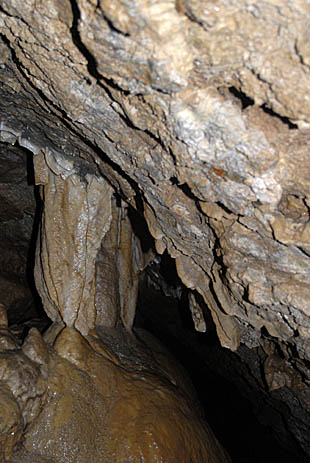 |
|
| |
|
|
Cave formations |
|
| |
The cave is hidden within a timbered mountainside that’s also worth exploring. Possibilities include the Big Tree Loop Trail, a 3.3-mile loop hike that begins at the visitor center near the cave entrance and climbs through old-growth forests, wildflower-laden meadows and offers vistas of the surrounding mountains and valleys.
|
|
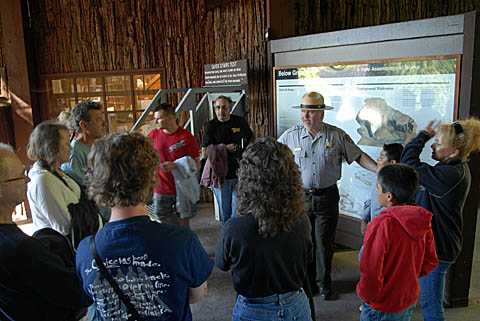 |
|
The No-Name trail loops 1.3 miles next to mossy cliffs and past dancing streams. Two other loop routes, each less than a mile long, are Old Growth, and Cliff, with panoramic views of the Illinois Valley. The 1.5-mile one-way Cave Creek trail follows the creek, which plunges out near the cave’s main entrance and dips through stands of oaks and conifers.
|
|
| |
|
|
Preparing for an outing |
|
|
|
| |
|
|
|
|
|
|
| |
Ambitious is the Bigelow Lakes Loop trail, which goes 4.5 uphill miles from the visitor center to Mount Elijah, a 6,390-foot elevation peak with expansive views of Southern Oregon and far Northern California, including 14,161-foot elevation Mount Shasta. The trail can be hiked as an extension of the Big Tree Loop. It passes by Bigelow Lake, gardens of seasonal flowers and a glacier-carved pond teeming with varieties of lilies. |
|
| |
|
|
| |
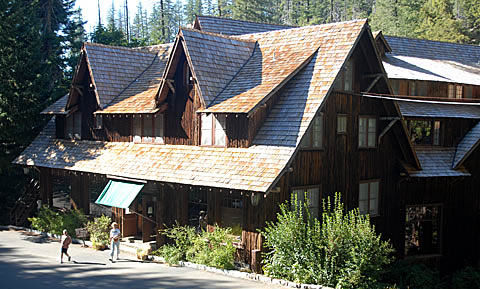
The classic Oregon Caves Chateau
Not all the park’s wonders are natural. Dazzling is Oregon Caves Chateau, a rustic Swiss-style wood-framed building securely nestled in a forested ravine by the cave entrance. With its shaggy exterior sheathed in Port Orford cedar bark, the wooden post-and-beam Chateau is a visual delight. Inside, the 75-year-old lodge has a 30-inch diameter log columns, a rustic staircase crafted from oak and madrone logs, a massive marble hearth, a 1930s style coffee shop and, in the dining area, a section of Cave Creek that’s been channeled to flow through the graciously elegant room. |
|
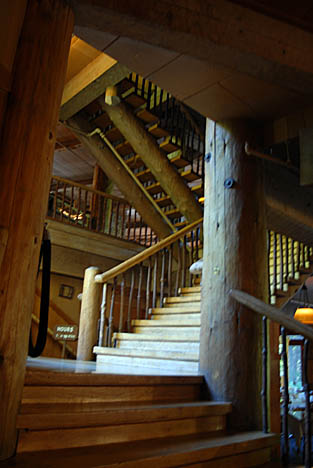 |
|
| |
|
|
Chateau’s rustic staircase |
|
| |
|
|
|
|
| |
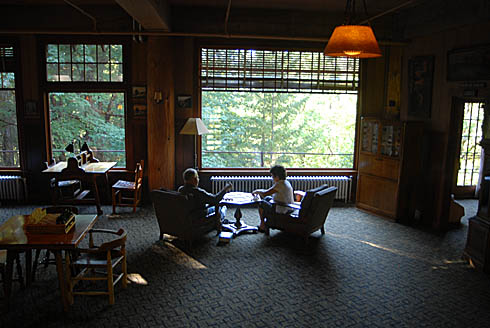 |
|
|
|
| |
Relaxing in the Chateau lobby |
|
The visitor center is a gathering place |
|
| |
|
|
|
|
| |
On a recent visit, friends and I admired the architecture, but relished the food in the Chateau’s dining room. We dined on scrumptious offerings, starting with grilled zucchini and Pacific crab cake appetizers and an apple spinach salad before devouring plates of Maltese halibut, vegetarian lasagna, rainbow trout and the Chateau’s signature meal, savory bison meatloaf and gravy.
Whether dining, staying in a room or just strolling through its expansive lobby, the Chateau is a delight. But the real reason for visiting is the cave. Take the conventional tour, explore with a lighted candle or get down and dirty. It doesn’t matter how you do it, but cave in and explore Oregon Caves underworld.
|
|
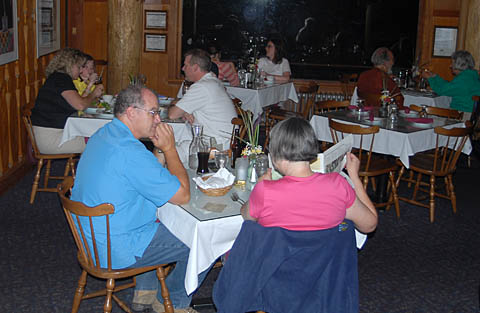 |
|
| |
|
|
Elegant Chateau dining |
|
| |
|
|
|
|
| |
 |
|
When You Visit
The only way to enter Oregon Caves is on ranger-led tours. The 90-minute standard tour meanders about a half-mile through sometimes low and narrow passages and climbs more than 500 steps. Good walking shoes and warm clothing – the cave temperature is a nippy year-around 40 degrees – are necessities. For those who can’t take the tours — people with canes, walkers or manually operated wheelchairs, or children less than 42 inches tall — the first room is accessible.
For a full schedule of activities visit the park visitor center, call 541-592-2100 or visit the website at http://www.nps.gov/orca
Reservations are not taken for regular cave tours, which are offered hourly in the spring and fall and every 30 minutes from mid-June to September 1, but they are necessary for the candlelight and off-trail tours. The Chateau’s Website is http://www.oregoncaveschateau.com while the Friends of Oregon Caves Website is http://www.friendsocac.org
|
|
| |
courtesy Oregon Caves National Monument |
|
| |
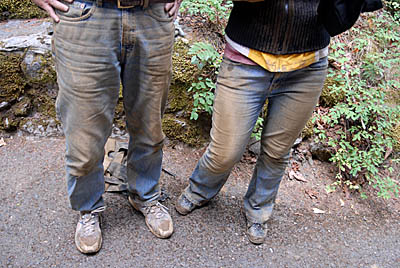 |
|
| |
The author and friend, after the off-trail tour |
|
| |
|
|
| |
About the Author
Lee Juillerat is a writer-photographer who lives in Klamath Falls, Oregon. He is also a frequent contributor to various magazines, including Northwest Travel, Range and Horizon and Alaska Airlines inflight publications. He can be contacted at mailto: [email protected] |
|
|
|
|

